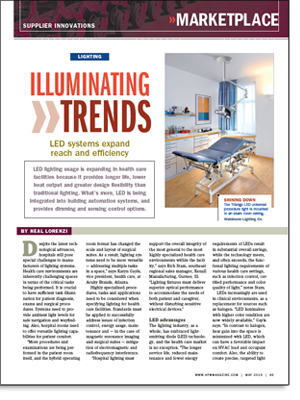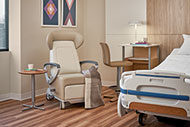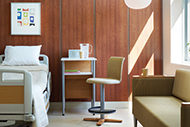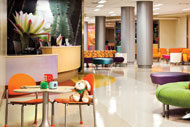
LED lighting usage is expanding in health care facilities because it provides longer life, lower heat output and greater design flexibility than traditional lighting. What's more, LED is being integrated into building automation systems, and provides dimming and sensing control options.
Despite the latest technological advances, hospitals still pose special challenges to manufacturers of lighting systems. Health care environments are inherently challenging spaces in terms of the critical tasks being performed. It is crucial to have sufficient task illumination for patient diagnosis, exams and surgical procedures. Systems need to provide ambient light levels for safe navigation and wayfinding. Also, hospital rooms need to offer versatile lighting capabilities for patient comfort.
"More procedures and examinations are being performed in the patient room itself, and the hybrid operating room format has changed the scale and layout of surgical suites. As a result, lighting systems need to be more versatile — addressing multiple tasks in a space," says Karyn Gayle, vice president, health care, at Acuity Brands, Atlanta.
Highly specialized procedures, tasks and applications need to be considered when specifying lighting for health care facilities. Standards must be applied to successfully address issues of infection control, energy usage, maintenance and — in the case of magnetic resonance imaging and surgical suites — mitigation of electromagnetic and radiofrequency interference.
"Hospital lighting must support the overall integrity of the most general to the most highly specialized health care environments within the facility," says Rich Stam, southeast regional sales manager, Kenall Manufacturing, Gurnee, Ill. "Lighting fixtures must deliver superior optical performance to accommodate the needs of both patient and caregiver, without disturbing sensitive electrical devices."
LED advantages
The lighting industry, as a whole, has embraced light-emitting diode (LED) technology, and the health care market is no exception. "The longer service life, reduced maintenance and lower energy requirements of LEDs result in substantial overall savings, while the technology meets, and often exceeds, the functional lighting requirements of various health care settings, such as infection control, certified performance and color quality of light," notes Stam.
LEDs increasingly are used in clinical environments, as a replacement for sources such as halogen. "LED luminaires with higher color rendition are now widely available," Gayle says. "In contrast to halogen, heat gain into the space is minimized with LED, which can have a favorable impact on HVAC load and occupant comfort. Also, the ability to create precise, targeted light distribution can reduce shadows and improve clinicians' visual acuity when performing critical tasks."
Along with advantages such as energy-efficiency and controllability, the use of LEDs can help facilities managers lower maintenance costs because of their longevity. For example, the fact that hospital staff spend less time climbing ladders to change ballasts and bulbs can translate into fewer accidents and worker's compensation claims.
The control issue
Increasing sophistication of lighting control is another trend worth watching, experts agree. Today's lighting control systems vary greatly in design — from traditional wired systems to cutting-edge wireless systems that can be connected to building automation systems for remote operation. This movement includes a trend to mood-setting or changing lighting levels in hospital rooms. In some cases, the lighting above a patient's bed can be designed to look like the sky, yet function as interior illumination.
"Hospitals are focused on patient care and the patient experience, and lighting can be fine-tuned based on these needs, including higher light levels for doctors and nurses versus lighting at warmer, comfort levels for patients," says Gregg Ryberg, director, health care sales, Cree Lighting, Durham, N.C. "Multifunctional lighting, using the same fixture to achieve various light levels, is beneficial for patients, as they can control light output as needed."
The latest systems enable patients to control their lights and window shades from the hospital bed. "Leading-edge technology integrates lighting and shading controls into the central IT system, which feeds information to and from the patient room," says Tom Myers, director, commercial real estate solutions, Lutron Electronics Co., Coopersburg, Pa. "Patients can, for instance, use their television remote to control their lights and shades, which improves comfort without relying on hospital staff."
Many hospitals are adopting designs that maximize the amount and quality of daylight that enters their facilities, also called daylight harvesting. "This is a great first step, but the addition of automatic day-lighting controls can reduce energy consumption and optimize the quality of light in the spaces where it is applied," Myers adds. In fact, day-lighting controls now available can save 20 to 60 percent in lighting costs.
There has been much discussion of the value of daylight in the patient experience, according to Lauren MacLeod, IALD, LEED AP, associate principal, senior lighting designer, Candela Lighting, Lynnwood, Wash. "Evidence-based design indicates that patients actually heal faster in day-lit areas with a visual connection to the world outside. We're doing more studies on how daylight enters a room, including defining elements of visual glare and comfort," she notes.
A newer consideration is the idea of "dialing up color temperature" — adjusting the color temperature of the lights to mirror the sun's color temperature as it changes throughout the day. This concept can be used to improve the degree of staff alertness and performance, as well as patient comfort and mood.
Saving energy
LED systems offer greater energy-efficiency and are easily connected to building automation systems, experts agree. "In many cases, LED is re-creating the same foot-candle delivery at 30 percent less energy consumption than incumbent light sources," says Pat Treadway, vice president of product marketing and engineering, MaxLite, West Caldwell, N.J.
New LED lighting is more energy-efficient, agrees Les Kaminski, senior manager of technical sales, Waldmann Lighting Co., Wheeling, Ill. "We have always offered energy-efficient light sources, such as T5 lamps with fluorescent fixtures, but new LED fixtures use lower wattages while maintaining or increasing light levels," he notes. "Our LED Triango is rated at 30W and produces 25 percent more light output than our 50W halogen ISIS fixture."
For the most part, LEDs can be more efficient, but it's critical to research the lighting system's specifications, cautions MacLeod. "No different from compact fluorescent, the lamp (or, in this case, diode) is only as good as the fixture manufacturer's design of the optical components (lenses and reflectors to control the lighting distribution) and heat management. LEDs are notoriously sensitive to heat," she notes. To that end, the Illuminating Engineering Society (www.iesna.org) has established uniform test procedures, which evaluate the luminous efficacy of the entire luminaire, not just the LED.
Make the connection
Experts see more LED integration with building automation systems and the use of control systems to optimize lighting performance in health care environments. The use of automatic day-light harvesting controls and nighttime light levels based on occupancy offers additional ways to save energy.
"We have seen HVAC companies include a lighting option because the package they installed for HVAC can control lighting and, by extension, control a possible source of heat in the building," says Treadway.
Stam agrees that, through the integration of various hardware and software components, lighting systems can be connected to building automation systems. "When paired with controls, the cost and energy savings of LEDs are enhanced and the return on investment can be particularly impressive," he notes.
Ray Sjolseth, president, Seesmart Technologies Inc., Simi Valley, Calif., says LED lighting systems are being integrated into hospital control systems in many forms. Some installations include occupancy sensors, which detect when an employee, patient or visitor has entered a room. "Because LEDs are solid-state devices, they can be turned on or off instantly with no warm-up time required. This makes LEDs attractive for implementation in all areas of hospitals," he says.
The selection process
Hospital facilities managers should consider many factors when selecting new lighting systems, experts suggest. "With so many LED fixtures flooding the market, there are many choices. But because the technology is new, fixture reliability and durability must be considered," says Kaminski. "LEDs require good heat management, so it is important to use well-known brands and companies that offer solid warranties."
Sjolseth says facilities managers must make sure they're dealing with an experienced LED supplier with a proven track record, as the marketplace is fragmented. "It's important to make sure the company selected has the scalability for a large project. Can it handle pre-purchasing products for a 1,000-fixture retrofit? Does it have a history of large project installations? All of these issues make the LED selection process for hospitals very difficult."
According to MacLeod, facilities managers must make sure the lighting manufacturer they select has "future-proofed" its products. She advises consulting with the Zhaga Consortium (www.zhagastandard.org), a group of manufacturers that strives to design LED modules that are interchangeable — similar to medium screw-base lamps — where multiple modules will fit into one base. "In a rapidly developing technology that's changing almost daily, having the ability to update and upgrade LEDs is a smart idea," she notes.
Future trends
Peering into the future, sources expect to see more wireless and automated lighting systems as well as more compact light sources that will fit into building plenum spaces. More organic light-emitting diode (OLED) technology is also on the horizon.
"As solid-state lighting becomes more pervasive, primarily due to mainstream LED adoption, the next big thing in lighting may be the advent of OLED technology," says Gayle. "With layers of organic materials that are thinner than a human hair, these diffuse light sources have the potential to revolutionize the way we light spaces in the future, delivering light at a more human scale in forms we never thought possible."
"Manufacturers have just begun commercializing OLED products in scale, and the potential for health care is tremendous," Gayle adds. HFM
Neal Lorenzi is a freelance health care writer based in Mundelein, Ill.
| Sidebar - For more information |
| For further details on the lighting systems featured in this article, readers can contact the following vendors: »Acuity Brands »Cree Lighting »GE Lighting »Kenall Manufacturing »Lutron Electronics Co. »MaxLite »Philips Color Kinetics »Seesmart Technologies Inc. »Waldmann Lighting Co. |





